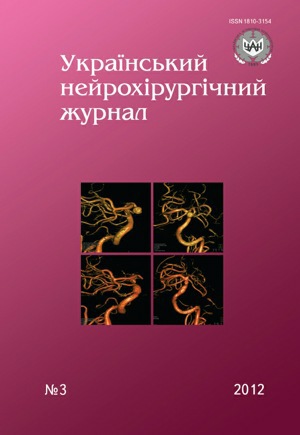Radical neurosurgical excision of sacral tumors, causing compression of neural structures, the results of treatment
DOI:
https://doi.org/10.25305/unj.60849Keywords:
sacral tumors, surgical treatmentAbstract
Introduction. Radical surgical removal of sacral tumors requires extensive operations performing, which cause pelvic ring stability lesion and probable neural structures damage.
Materials and methods. The data, obtained at analysis of different examination methods, radical surgical “block” excision of sacral tumors, clinical results of treatment of 12 patients with sacral tumors, operated in 2009–2012, are given. In 10 of them large tumors with all sacrum lesion (SI–SV vertebrae) were revealed, in 2 — with upper sacral vertebrae lesion (SI–SIII), in 1 — lower sacral vertebrae lesion (SIII–SV). In all patients after tumor excision pelviolumbar fixation was done.
Results. In the late period results of 12 patients (group A) treatment, at wich tumor “block” removal was performed, were compared with results of 23 patients treatment (group B) with sacral tumors, removed by division into parts. In 10 of them large sacral tumors were found with all sacrum lesion (SI–Sv), in 8 — upper sacral vertebrae lesion (SI–SIII), in 5 — lower sacral vertebrae lesion (SIII–SV). In 6 patients after tumor excision pelviolumbar fixation was done.
Conclusion. Results of treatment and prognosis at sacral malignant tumors were better after radical surgery, reliable intraoperative spine to the pelvic ring fixing, use of radiotherapy and chemotherapy after operation.
References
1. Zhang ZY, Fu CF, Yang YX, Wang LQ, Cui Y, Liu Y. Long-term outcomes following en bloc resection for sacral tumor: a retrospective analysis of 93 cases. Orthopedics. 2011;34(8):403-407. [CrossRef] [PubMed]
2. Lee YP, Ghofrani H, Regev GJ, Garfin SR. A retrospective review of long anterior fusions to the sacrum. Spine J. 2011;11(4):290-294. [CrossRef] [PubMed]
3. Brown MJ, Kor DJ, Curry TB, Warner MA, Rodrigues ES, Rose SH, Dekutoski MB, Moriarty JP, Long KH, Rose PS. Sacral tumor resection: the effect of surgical staging on patient outcomes, resource management, and hospital cost. Spine. 2011;36(19):1570-1578. [CrossRef] [PubMed]
4. Asavamongkolkul A, Waikakul S. Wide resection of sacral chordoma via a posterior approach. Int Orthop. 2012 Mar;36(3):607-12. [CrossRef] [PubMed]
5. Katsuno H, Maeda K, Hanai T, Sato H, Masumori K, Koide Y, Matsuoka H, Noro T, Takakuwa Y, Hanaoka R. Trans-sacral resection of a solitary fibrous tumor in the pelvis: report of a case. Surg Today. 2011;41(11):1548-1551. [CrossRef] [PubMed]
6. Stener B, Gunterberg B. High amputation of the sacrum for extirpation of tumors. Spine. 1978;3(4):351-366. [CrossRef] [PubMed]
7. Ahuja S, McCanna S, Horn E. Treatment strategy for chondromyxoid fibroma of the sacrum. Journal of Clinical Neuroscience. 2011;18(11):1550-1552. [CrossRef] [PubMed]
8. McCarty CS, Waugh JM, Mayo CW, Coventry MB. The surgical treatment of presacral tumors: a combined problem. Proc Staff Meet Mayo Clin. 1952;27(4):73-84. [PubMed]
9. Mendel E, Mayerson J, Nathoo N, Edgar R, Schmidt C, Miller M. Reconstruction of the pelvis and lumbar-pelvic junction using 2 vascularized autologous bone grafts after en bloc resection for an iliosacral chondrosarcoma. Journal of Neurosurgery: Spine. 2011;15(2):168-173. [CrossRef] [PubMed]
10. Choudry U, Moran S, Karacor Z. Functional Reconstruction of the Pelvic Ring With Simultaneous Bilateral Free Fibular Flaps Following Total Sacral Resection. Annals of Plastic Surgery. 2006;57(6):673-676. [CrossRef] [PubMed]
11. Fourney D, Rhines L, Hentschel S et al. En bloc resection of primary sacral tumors: classification of surgical approaches and outcome. Journal of Neurosurgery: Spine. 2005;3(2):111-122. [CrossRef] [PubMed]
12. Dickey I, Hugate R, Fuchs B, Yaszemski M, Sim F. Reconstruction after Total Sacrectomy. Clinical Orthopaedics and Related Research. 2005;438:42-50. [CrossRef] [PubMed]
Downloads
Published
How to Cite
Issue
Section
License
Copyright (c) 2012 Eugene Slynko, Alexander Zolotoverkh, Iyad Al-Kashkish, Iyad, Artur Ermoliev

This work is licensed under a Creative Commons Attribution 4.0 International License.
Ukrainian Neurosurgical Journal abides by the CREATIVE COMMONS copyright rights and permissions for open access journals.
Authors, who are published in this Journal, agree to the following conditions:
1. The authors reserve the right to authorship of the work and pass the first publication right of this work to the Journal under the terms of Creative Commons Attribution License, which allows others to freely distribute the published research with the obligatory reference to the authors of the original work and the first publication of the work in this Journal.
2. The authors have the right to conclude separate supplement agreements that relate to non-exclusive work distribution in the form of which it has been published by the Journal (for example, to upload the work to the online storage of the Journal or publish it as part of a monograph), provided that the reference to the first publication of the work in this Journal is included.









